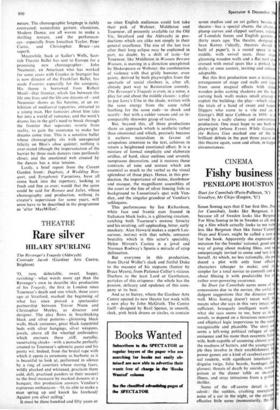THEATRE
Rare silver
HILARY SPURLING
The Revenger's Tragedy (Aldwych) Comrade Jacob (Gardner Arts Centre, Brighton) '0, rare, delectable, sweet, happy, ravishing'—what words more apt than the Revenger's own to describe this production of his Tragedy, the first in London since Tourneur's death and one which, three years ago at Stratford, marked the beginning of what has since proved a spectacular partnership between Trevor Nunn and Christopher Morley, as director and designer. The play flows in breathtaking black and silver patterns—glistening black walls, black costumes, great black tapestried beds with silver hangings, silver weapons, jewels, above all the whorled embroidery which encrusts these .,stiff, metallic, susurrating cloaks—with a.panache perfectly attuned to Tourneur's splenetic gusto and his pretty wit. Indeed, from the brutal rape with which it opens (a ceremony as barbaric as it is beautiful to look at, performed in silence by a ring of courtiers whose staring faces, wildly plucked and whitened, proclaim them cold, deft, practised panders to their master) to the final massacre by masked dancers at a banquet, this production answers Vendice's rapturous enthusiasm—'O, tis able to make a man spring up and knock his forehead/ Against yon silver ceiling.'
It must be three hundred and fifty years or
so since English audiences could last take their pick of Webster, Middleton and Tourneur, all presently available (at the Old Vic, Stratford and the Aldwych) in pro- ductions which are alike not simply in their general excellence. The rise of the last two after their long eclipse may be explained in part, no doubt, by a shift of taste—for Tourneur, like Middleton in Women Beware Women, is moving in a direction unexplored by Shakespeare or Webster; the combination of violence with that grisly humour, even gaiety, derived by both playwrights from the spectacle of social climbers is, after all, already part way to Restoration comedy. The Revenger's Tragedy is even, in a sense, a play for and about the middle classes: a play to put Jarry's Ubu in the shade, written with the same energy from the same rabid loathing for the same ends—to shock and scarify—but with a colder venom and an in- comparably shrewder grasp of tactics.
But, beyond- this, all three productions share an approach which is aesthetic rather than emotional and which, precisely because it eschews naturalism in favour of scrupulous attention to the text, achieves in return a heightened emotional effect. It is a mixture of formal simplicity and elaborate artifice, of hard, clear outlines and severely sumptuous decoration, and it restores those contrasts of tone and texture which are essential as much to the verbal as the visual splendour of these plays. Hence, in this pro- duction, the importance of mime, dumbshow and masque, the magnificent assemblies of the court or the line of silver fencing foils as background to Lussurioso's spat with Ven- dice, and the singular grandeur of Vendice's soliloquies.
This performance by Ian Richardson, white face and frantic eyes framed in Italianate black locks, is a glittering creation, catching both Tourneur's morose ferocity and his strutting. self-applauding, bitter, surly mockery. Alan Howard makes a superb Lus- surioso, instinct with that subtle, sensuous brutality which is this actor's speciality, Helen Mirren's Castiza is a jewel and Norman Rodway's Spurio a miracle of crisp delineation.
But everyone in this production, from David Waller's slack and fretful Duke to the meanest of his stepsons (Junior by Bruce Myers), from Patience Collier's vicious Duchess to the least Lord or Gentleman, partakes of this crispness: the whole has the passion, delicacy and opulence of this com- pany at its best.
And so to Surrey, where the Gardner Arts Centre opened its new theatre last week with a new play by John McGrath. The Centre itself—designed by Basil Spence, in smooth, sleek, pink brick drums or circles, to contain
seven studios and an art gallery besides theatre—has a special charm, the charm plump curves and clipped surfaces, redole of Lonsdale farces and English gardens thirty years ago. The theatre, designed Sean Kenny ('ideally, theatres should built of paper'), is a round space in middle, with swivel seats, three stag gleaming wooden walls and a flat roof cri crossed with metal spars like a pinked, la doily; at once austere, inviting and infinite adaptable.
But this first production uses a tradition arrangement of stage and stalls and (apa from some magical effects with slend wooden poles casting shadows on the bar curving back wall) makes small attempt exploit the building; the play—which relat the trials of a band of sweet and hopei Diggers who came to a vile end on George's Hill near Cobham in 1694—is served by a sadly clumsy and convention production. One must hope to see both t playwright (whose Events While Guardin the Bofors Gun marked one of the f brilliant debuts in the past three years) an this theatre again, soon and often, in happi• circumstances.






































 Previous page
Previous page